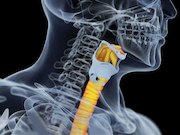Bioengineered tracheal and bronchial reconstruction reported using stented aortic matrices
MONDAY, May 21, 2018 (HealthDay News) — Airway bioengineering appears feasible for tracheal and bronchial reconstruction, according to a study published online May 20 in the Journal of the American Medical Association to coincide with the American Thoracic Society’s 2018 International Conference, held from May 18 to 23 in San Diego.
Emmanuel Martinod, M.D., Ph.D., from the Hôpitaux Universitaires Paris Seine-Saint Denis, and colleagues recruited 20 patients with end-stage tracheal lesions or with proximal lung tumors requiring a pneumonectomy. Standard surgical techniques were used to perform radical resection of the lesions; airway reconstruction was performed after resection using a human cryopreserved aortic allograft. A custom made stent was inserted into the allograft to prevent airway collapse.
Thirteen patients underwent tracheal, bronchial, or carinal transplantation; in seven patients, airway transplantation was not performed. The researchers found that the 90-day mortality rate was 5 percent among the 20 patients. Patients who underwent tracheal or bronchial reconstruction had no mortality at 90 days. Major 90-day morbidity events occurred in four of the 13 patients who underwent airway transplantation. At a postoperative mean of 18.2 months, stent removal was performed. Ten of the 13 patients were alive at a median follow-up of three 3 years 11 months; eight of these breathed normally through airways newly formed after stent removal.
“Airway bioengineering using stented aortic matrices demonstrated feasibility for complex tracheal and bronchial reconstruction,” the authors write.
Several authors disclosed financial ties to the pharmaceutical industry.
Copyright © 2018 HealthDay. All rights reserved.








